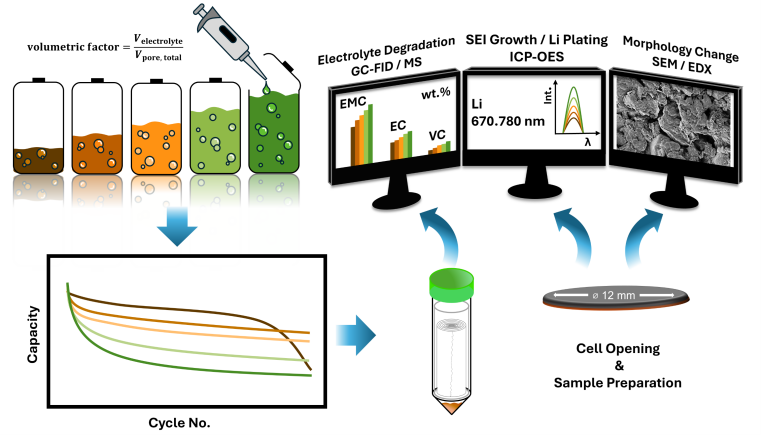Influence of Electrolyte Quantity on Aging of Lithium-ion Batteries
The electrolyte is a crucial parameter for further improving lithium-ion batteries. It is not only its composition that has a decisive influence on the performance and lifetime of the cells, but also its quantity. However, the importance of the electrolyte quantity has not been sufficiently investigated. Using comprehensive post mortem analyses, a team from MEET Battery Research Center at the University of Münster and the Technical University of Munich has now examined how the electrolyte quantity affects the aging process. The scientists investigated three different electrolyte compositions.
Interdependence of Additive Concentration and Electrolyte Volume as a Significant Effect on the Aging Mechanism
For each of these compositions, the researchers compared cells that differed in the volume of the electrolyte added. “We examined each individual component in detail. By varying the electrolyte quantity, we were able to minimize differences in cell performance, caused for example by continuous decomposition of the electrolyte, and suppress aging effects,” says MEET scientist Christian Lechtenfeld. The results show that the absolute additive amount in particular depends sensitively on the electrolyte volume added. The team used complementary analytical methods to shed light on this sensitive interdependence in order to gain a deeper understanding of its complex influence on the lifetime and aging behavior of the individual cell components. “Based on these findings, it is now possible to identify the optimum filling volume and the precise additive concentration more accurately,” says Lechtenfeld.

Julius Buchmann, PhD student at MEET Battery Research Center and the International Graduate School for Battery Chemistry, Characterization, Analysis, Recycling and Application (BACCARA), concludes: “By adjusting both the composition of the electrolyte and its volume based on the cell-specific properties, we can further increase the lifetime of lithium-ion batteries.”
Detailed Results Available Online
The entire study has been published by the authors Christian Timo Lechtenfeld, Julius Buchmann, Marlena M. Bela, Stefan van Wickeren, Dr Simon Wiemers-Meyer and Dr Sascha Nowak, MEET Battery Research Center, Prof. Dr Martin Winter, MEET Battery Research Center and Helmholtz Institute Münster of Forschungszentrum Jülich, as well as Jan Hagemeister, Sandro Stock and Prof. Dr Rüdiger Daub, Technical University of Munich, in the journal “Advanced Science”.

